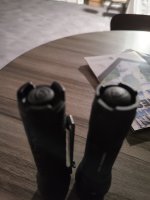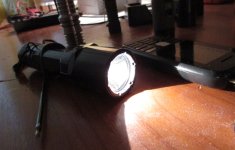I'm not worried about batteries. I don't care about the drop in capacity as long as I'm happy with the running time
for a few dollars I can buy fresh ones
For a few dollars maybe you can buy
one, medium capacity (2000-2500mAh), unlabeled generic 18650, if that.
But known high quality cells cost more, for example
Keeppower P1826C 5.2A 2600mAh Protected Button Top
Samsung 26J 18650 5.2A 2600mAh Protected Button Top
These are probably the same cell, but I'm having trouble finding protected cells in that capacity range. Most are higher capacity and more expensive, unless ordering wholesale in bulk from China. Just by what I'm seeing, I think maybe the trend is LiCo protected cells are disappearing. The two cells above are hybrid INR or LiNiMnCoO2, which, strictly speaking, do not require protection. There's bound to be plenty of LiCo protected cells still available somewhere, but I wonder if manufacturing has slowed or stopped, because they used to be by far the most plentiful and now INR and IMR (LiMn, which I have never seen protected) seem to be easier to find right now. HKJ pointed this out to me a couple years ago, that all new Li-ion cells were hybrid chemistries, and it sort of went in one ear out the other.
and I wonder if it was worth my time worrying about their condition?
The reality is the cells you're talking about are now $5-$8/pc in the US. I made the same mistake with Duracell Solar 18500 1200mAh LiFePO4 cells I picked up at Home Depot thinking they were cheap at $12/pair, and I took them for granted. Only later did I realize that they were decent cells, and I really liked them, and they were no longer available, and by then I couldn't afford them anyway (but that's just me, I'm destitute, and I expect nearly everyone has more cash flow).
It is possible that this is indeed a turn off / turn on of the protection circuit, but this does not happen with LED lights - it just turns off, and does not turn on until it is charged. Without the right test equipment, it's impossible to say for sure what it is.
I made this quick test in response to the comment that protected cells are left in the dark. As you can see, this is not the case
These statements conflict with each other. If what you describe was an intended feature of the cell, to warn the user, don't you think they would advertise that? And I expect any protected cell to behave this way, so to say, "there's no way to know" is a bit disingenuous. I think it's just how protected cells will behave because of how I described it in the previous post, and I think I would see that behavior myself if my LiCo cells weren't 7 years old and so well used, because I nearly see it now, just with a longer delay between flashes, which is how I'd expect an older cell to behave, i.e. recover it's resting voltage slower with less available current.
Check this out.
Vapcell N36 INR18650 3.7V 8A 3650mAh
You can get these 10 at a time direct from the Vapcell factory for $36, about the price of 5-7 protected 2500mAh cells domestically (which I can't find direct from factory anymore, maybe you can), and not only get more cells but about 40% more capacity per cell with a much higher amp rating, but you'll probably never see this cell protected because it doesn't need it. But even pedestrian capacity INR and IMR cells usually have at least 3000mAh.
The hybrid chems are really great, and it's really a good thing they don't need protection. The reason for the protection on LiCo isn't to warn to user, it's to prevent them from discharging the cell below 2.5V and subsequently placing a damaged cell back on a charger, because bad things can happen (but it's also to cut off voltage for too high a current draw before thermal runaway becomes a risk).
Not to mention, more and more flashlights are being designed with LVP built in, further making protected cells obsolete.
But even if my conjecture is wildly inaccurate, and yours is 100% correct, protected cells are getting less and less common, so I wouldn't get too attached to them because there might not be any available five years from now. So if you like them, there's a good reason to be worried about your cells and take care of them, because you may never see their kind again (I'm exaggerating to make a point, which is that LiCo protected cells will fully disappear eventually, maybe sooner than later).



